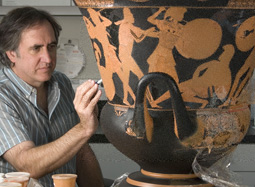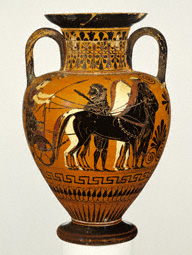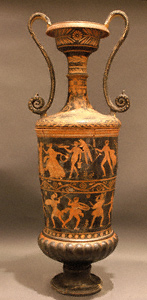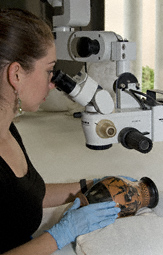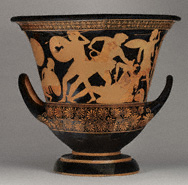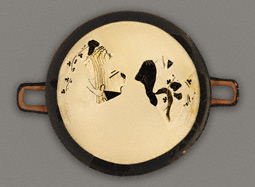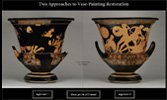| Education | ||
| Exhibitions | ||
| Explore Art | ||
| Research and Conservation | ||
| Bookstore | ||
| Games | ||
| About the J. Paul Getty Museum | ||
| Public Programs | ||
| Museum Home
|
December 18, 2008–June 1, 2009 at the Getty Villa
Terracotta vessels make up the majority of objects that survive from ancient times, but most are found only as fragments. |
|||||||||||||||||
Ancient Repair In antiquity, highly valued vessels were repaired using a variety of techniques, including metal pinning and stapling. Adhesives such as animal and vegetable glues may also have been used, though little evidence remains to identify them. Ancient repairs were often removed during 18th- and 19th-century restorations, but today conservators preserve them as historical evidence. When part of a vase was missing or badly damaged, ancient craftsmen sometimes added a similar section from another vessel to make the repair. This amphora (storage jar) broke in ancient times and was repaired with the rim and part of the neck of a vase with a parallel shape, but a different floral design. |
|||||||||||||||||
18th- and 19th-Century Restoration Enthusiastic collecting of antiquities in the 1700s and 1800s created a market for classical vases painted with interesting scenes. The restoration practices of collectors and dealers of this period focused on presenting the illusion of an undamaged, complete object. In many cases, restorers reshaped fragments, painted over the original surface, and invented iconography or inserted pieces from other ancient vases to make scenes more appealing.
One of a pair, this water jar was found in the early 1800s at a grave site in Ceglie, Italy. As was typical of the 19th century, the broken object was restored to appear intact. The vase was reconstructed using natural adhesives and reinforced internally with a plaster lining. In addition, filled losses, cracks, and surrounding areas of the ancient ceramic were painted to conceal damage. |
|||||||||||||||||
Contemporary Techniques Before beginning a restoration project, Getty conservators and scientists employ a variety of non-destructive methods to analyze ancient vases for information about their manufacture, condition, and past attempts at repair and restoration. Methods of examination range from visual inspection aided by low-power microscopy to ultraviolet (UV) visible fluorescence, X-radiography, and X-ray fluorescence (XRF) spectroscopy. Even a few fragments can provide a wealth of information.
Following inspection, conservators develop an approach to the restoration of a vase. A vessel's dimensions and painted design are determined based on measurements and drawings of the surviving fragments, as well as studies of similar vases.
While 18th- and 19th-century restorers often strove to create the illusion of an unbroken artifact and 20th-century techniques emphasized the difference between modern fills and ancient areas, the current approach to restoration at the Getty Villa strives to visually integrate filled areas and make them less obtrusive while still distinguishing them from the original ceramic and preserving an object's history. |
|||||||||||||||||
Case Study: A Mixing Vessel This unusually large krater (mixing vessel) was recently restored at the Getty Villa from a number of fragment groupings. It depicts an Amazonomachy, a battle between Greeks and Amazons (women warriors).
|
|||||||||||||||||
Case Study: A Rare Cup The restoration of this kylix (wine cup) at the Getty Villa was prompted by its rarity. It is one of only three known cups decorated using an unusual combination of techniques: black-figure painting, outline drawing, and added-clay relief over a white ground.
|
|||||||||||||||||
Case Study: A Funerary Jar This monumental funerary vessel was pieced together from 136 fragments in the 19th century. |
|||||||||||||||||
|
||||||||||||||||||||||||||||||||||
